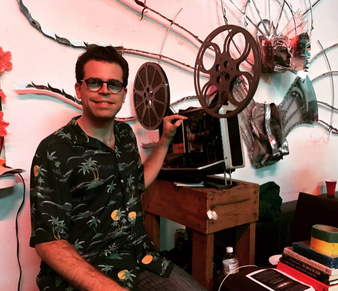about tommy josé

Hi, I'm Tommy José Stathes. I'm an early animation historian, archivist, and preservationist based in New York City. My work and interest within film deals with a very specific area of film history: the earliest animated cartoons, produced from the 1900s to the 1930s. It's a subject that has been studied and written about for several decades, but it's also a genre where examples of the films have been somewhat difficult to see for a variety of reasons, and where few formal long-term attempts have been made to preserve the art form as a whole. My work involves not only researching the history of early cartoons, but more importantly, collecting and archiving as many examples as possible, so more and more surviving titles of these films can easily be studied, enjoyed, and made available for reuse in one location, from one source. I work with film archives, private collectors, and other sources to make this possible, and have gradually developed multiple means to share these films with the public.
my mission
The goals of my work are to:
• Physically reunite a historic body of works that belong to an under-researched and under-preserved niche within film history
• Entertain and educate others about animation history and antique film technology through live presentations
• Gradually make archival films available to worldwide audiences and scholars through vehicles such as home video.
• Physically reunite a historic body of works that belong to an under-researched and under-preserved niche within film history
• Entertain and educate others about animation history and antique film technology through live presentations
• Gradually make archival films available to worldwide audiences and scholars through vehicles such as home video.
how it all began
 The 1990s
The 1990s
I've had a lifelong attraction to two very specific subects: history, and animated cartoons. My love for cartoons came first, in infancy, and my passion for learning about history and collecting historical objects came a bit later, at the wise old age of five.
In the 1990s, one could walk into a drugstore or supermarket and find inexpensive VHS tapes (pictured at right) containing vintage cartoons, mainly from the 1930s and 1940s. My interests were fueled thanks to the existence of these tapes, and they became my vehicle for collecting and viewing whatever vintage cartoons were available.
I spent some time with the usual '90s kid fare of videogames, but I much more frequently looked forward to VHS-hunting in stores. A related pastime was asking my grandparents about the cartoons they saw in theaters in the 1930s, as well as chatting with my parents about those same cartoons, which they later saw on television in the 1950s and '60s.
Right from the start of my cartoon viewing, I was able to see a couple of much scarcer silent-era cartoons on these tapes, including Felix the Cat among others. Eventually, I was reading some of the contemporary history books on animation, and realized that too few of these earlier cartoons were available for viewing. I then set out on a mission to find more of them, and the rest is history.
In the 1990s, one could walk into a drugstore or supermarket and find inexpensive VHS tapes (pictured at right) containing vintage cartoons, mainly from the 1930s and 1940s. My interests were fueled thanks to the existence of these tapes, and they became my vehicle for collecting and viewing whatever vintage cartoons were available.
I spent some time with the usual '90s kid fare of videogames, but I much more frequently looked forward to VHS-hunting in stores. A related pastime was asking my grandparents about the cartoons they saw in theaters in the 1930s, as well as chatting with my parents about those same cartoons, which they later saw on television in the 1950s and '60s.
Right from the start of my cartoon viewing, I was able to see a couple of much scarcer silent-era cartoons on these tapes, including Felix the Cat among others. Eventually, I was reading some of the contemporary history books on animation, and realized that too few of these earlier cartoons were available for viewing. I then set out on a mission to find more of them, and the rest is history.